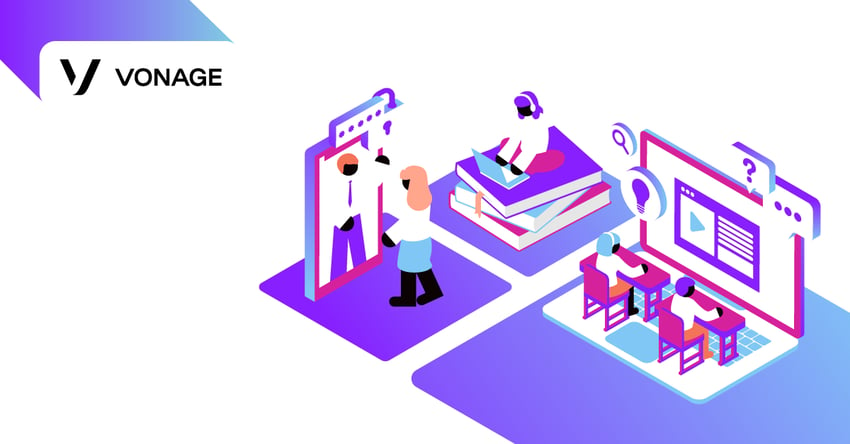How Cloud Communications Push Digital Transformation in Education
When the COVID-19 pandemic hit, people across the world were forced to change the way they lived. From shifting to fully remote work to avoiding restaurants and shops, almost every aspect of daily life was disrupted. And one of the most impacted areas has been education.

Widespread school closures ultimately left students and parents with a startling new reality: online learning.
As a result, administrators and education leaders were faced with the difficult task of quickly navigating cloud communications and digital transformation tools to effectively provide online learning to students. And while online learning is nothing new, it has never been implemented on such a broad scale.
For years, schools have experimented with online courses and interactive learning lessons here and there, but the digital transformation required to achieve full-time online learning is immense. By October 2020, almost a year after the initial outbreak, 45 percent of parents said they would still choose partial virtual learning, according to a National Parents Union Survey — a sign of how far cloud communications and other tools have come in the education sector.
Still, it's clear that the ongoing effort to digitally transform schools has shown success. Here's a look at what education chief information officers and other technical stakeholders should consider as they continue to refine and roll out their own transformation plans, with a focus on communications tools that enable higher-level planning.
Cloud Communications in the Classroom
Naturally, a quality education relies on strong communication, from the earliest levels of learning all the way to higher education. In the classroom, skilled communicators craft their message for maximum absorption, ensuring all students get an opportunity to improve and engage.
In the classroom, the right solution makes digital transformation initiatives designed to tap into students' love of social sharing even more powerful and effective. For example, a class using teacher- or class-led virtual lectures could take advantage of a platform with private sharing, bypassing the need to upload content to public-facing services, such as YouTube or Soundcloud. Meanwhile, video conferencing tools built into cloud communications platforms can increase engagement during parent–teacher conferences by giving parents a greater opportunity to engage and collaborate with their children's educators.
Cloud communications solutions can also make it easier for teachers to reach out to their students without compromising privacy. For instance, imagine that a teacher needs to text two of her six classes to clarify a point on a recent lesson. Pushing a message that only reveals the sender to students' school-provided tablets ensures a high degree of engagement without giving either party access to the other's phone number. The tablets may be the main focus of transformation in this story, but a competent communications platform provides crucial infrastructure. The school is now equipped to give all students access to the education they need in the new normal.
Time and Cost Savings
Cloud communications can also be a considerable benefit for connecting institutions. Wired phone systems (frequently referred to as private branch exchanges, or PBXs) can be costly and complex, while cloud-based systems offer several notable advantages. Schools making smart devices a part of their digital transformation strategy could enable teachers to carry their desk phone numbers from location to location — an upgrade that makes it easy for stakeholders to reach faculty and for faculty to call from their "home base," no matter where they happen to be.
The same high-level benefit makes it easier and less costly to add numbers and features. IT personnel can make changes and provision features from an online portal instead of calling the phone company and waiting to see how long the change will take.
For any school planning to upgrade its digital capabilities, communications platform savings are a key benefit. This is especially so in the budget-bound educational world, where the total cost of ownership is a primary decider of any major purchase. When the institution doesn't have to pay for PBX hardware or maintain as many on-premises digital assets — and when it can avoid many of these financial responsibilities while also adding cutting-edge communications features — the upfront implementation costs become far easier to bear. Fewer servers bought per location directly means more money in the institution's pocket.
Integrations can simultaneously grow an institution's technological capability and reduce its upfront and recurrent expenses. A given school's technological footprint likely includes numerous homegrown and off-the-shelf solutions. For IT, introducing a new element into this mix can make it all the more challenging to "keep the lights on" from day to day.
Modern cloud-based communications platforms, however, integrate with popular third-party tools and make it easier to merge with solutions the school developed itself. This offers several distinct advantages, including the ability to centralize dense attendance and faculty records and the ability to begin working toward a unified transformation plan.
Talking Transformation
In education, one-size-fits-all solutions just don’t work. Every institution needs its own complex blend of digital transformation tools to get the most from its efforts. That goes for schools within larger systems, too. And while there’s no universal collection of tools that affect better learning and financial savings across the board, cloud communications tools provide the glue that helps make other changes stick.
When the institution can provide effortless communication via voice, text, or video without worrying about upkeep for on-premises hardware, everyone benefits. And given the state of the world right now, being able to connect teachers and students is invaluable.